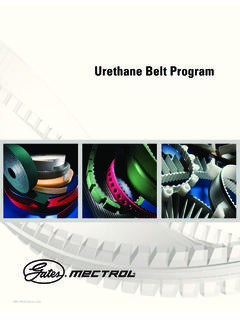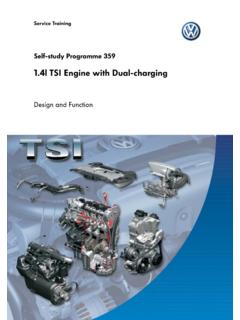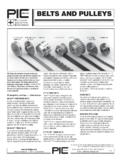Transcription of Timing Belt Welding - Mädler
1 128 1291311321331341351361371381391401421441 4614814915015115315415615816116216216416 6167168169170171172175177178180182 Timing belt Drives - OverviewDescription and selection guide ..Calculation (dimensioning) ..Performance Figures T-Profile ..Performance Figures AT-Profile ..Performance Figures HTD 3M and 5M ..Performance Figures HTD 8M and 14M ..Performance Figures Inch-Profile MXL and XL ..Performance Figures Inch-Profile L and H .. pulleys T and T 5 made from plastic .. pulleys T made from aluminium .. pulleys T 5 made from T 10 made from aluminium .. pulleys AT 5 made from aluminium .. pulleys AT 10 made from aluminium .. pulleys HTD 3M made from aluminium .. pulleys HTD 5M made from steel or aluminium .. pulleys HTD 5M for Taper clamping bush .. pulleys HTD 8M made from steel or cast options for drive wheels .. pulleys HTD 8M for Taper clamping bush .. pulleys HTD 14M for Taper clamping bush.
2 Taper clamping bushes .. pulleys Inch-Profile MXL made from aluminium .. pulleys Inch-Profile XL made from aluminium .. pulleys Inch-Profile L made from Steel or cast iron .. pulleys Inch-Profile H made from Steel or cast iron ..Splined shafts T-Profile ..Splined shafts AT-Profile ..Splined shafts HTD-Profile ..Splined shafts Inch-Profile ..Flanges for Timing belt pulleys ..Fixing Plates for open-length Timing belts ..Open-length Timing belts .. Timing belts T-Profile .. Timing belts AT-Profile .. Timing belts HTD-Profile .. Timing belts Inch Pitch ..Tensioning rollers and tensioning elements ..Contents PageTiming belt Weldingwithin 24h-Service129 Type Profile Pitch Overall Height** Tooth Height Tensile Force mm mm mm N*Metric 120 T5 330 T10 780 Metric AT5 5 700 AT10 10 1300 Timing belt ProfilesType Profile Pitch Overall Height Tooth Height Tensile Force mm mm mm N*HTD 3M 3 100 5M 5 208 8M
3 8 375 14M 14 425 Inch MXL 39 XL 56 L 98 H 235 Timing - belt Drives - DescriptionGeneral DescriptionTiming- belt drives enable a quiet operation and synchronous trans-mission of power. As they are maintenance free, these drives are very cost efficient. Due to varying requirements and consideration of the latest developments, there are a large number of different profiles, belt types and pulleys on the market. When non-positive drives ( v- belt systems) are replaced, it is worth considering whether a conversion to a positive power transmission could be allowed from a safety point of view (some drives require slip at overload).
4 Selection and DimensioningThe belt material and type of Timing belt must be selected consider-ing the specific situation ( required features regarding machine or surroundings). There are performance tables and a user-friendly calculation programme on the internet to help you select the cor-rect size. Small pulley diameters reduce the service life. And at least 6 teeth should be engaged at any consulting the performance tables, several application-specif-ic operating factors must be and MaintenanceAt least one pulley must be equipped with flanges. The axes must be parallel (deviation no more than + ). The belt must not be overstretched during mounting. For mounting and adjustment of the ideal belt there have to be sufficient possibilities for adjustment incorporated into the TensionEach belt needs a certain pre-tension, depending on the type of belt , pulley diameter, center distance and the tangential force to be transmitted.
5 The overall sum of tensioning and peripheral force must not exceed the permitted tensile force of the belt . The belt tension is best adjusted by altering the center distance. Otherwise a smooth tensioning pulley mounted on the outside or a toothed one on the inside of the belt may be used for of degree of efficiency deDepending on the type of belt (flexibility) and the number of teeth on the pulley (bending) the degree of efficiency can reach 98 %. Belts with tensile members of glass fibre cords (HTD and Inch) are particularly flexible. Classical, trapezoid profile in accordance with DIN 7721 with met-ric dimensions, pitch mm, 5 mm and 10 mm in several widths. Pitch 20 mm and other widths available on request. Often used, cost-efficient, clean standard belt drive in many areas of machine building, also in the food industry. Polyurethane (PU) Timing belts with tensile members of steel, little lengthening Little and light-coloured abrasion, good resistance against oil, fats and many chemicals.
6 Temperature range -30 to +80 C. Good flex-ibility. Open length belts from thermoplastic polyurethane TPU can get welded to endless belts in special lengths. cost-efficient pulleys made from aluminium (some also made from plastic) pre-bored (custom bore etc. at extra charge). T Timing belt drives do not feature little backlash (low backlash or zero backlash pulleys can be especially manufactured on request).T Timing belt Drives Trapezoid profile especially designed to transmit high power, with metric dimensions, pitch 5 mm and 10 mm, in stock in several widths. Pitch 20 mm and other widths available on request. Clean belt drive used in many areas of machine building, also in the food industry. Polyurethane (PU) Timing belts with tensile members of steel, little lengthening Little and light-coloured abrasion, good resistance against oil, fats and many chemicals. Temperature range -30 to +80 C.
7 Good flex-ibility. Open length belts from thermoplastic polyurethane TPU can get welded to endless belts in special lengths. Cheap pulleys made from aluminium (some also made from plastic) pre-bored (custom bore etc. at extra charge). AT Timing belt drives do not feature little backlash (low backlash or zero backlash pulleys can be especially manufactured on request). AT Timing belt Drives Heavy-duty Timing belt with half-round teeth profile, with metric dimensions, pitch 3 mm, 5 mm, 8 mm and 14 mm. Low-backlash belt drive with high efficiency used in many areas of machine building. Neoprene Timing belts with tensile member of glass-fibre. Little, but dark abrasion. Temperature range -20 to +100 C. Up to medium speed quiet. At higher speed some noise due to the fast movement of air out of the tooth gaps. Pitch-true, more expensive pulleys made from steel (pitch 3M made from aluminium, pitch 5M from 44 teeth made from aluminium).
8 pulleys pre-bored (custom bore etc. at extra charge), pitch 8M and 14M also prepared for Taper clamping bush. Classical trapezoid profile in accordance with ISO 5294 (ex DIN ISO 5296) with inch dimensions, profile MXL, XL, L and H (pitch = mm to 1/2 = mm), in several widths. Other sizes on request. Classical Timing - belt drive which is, apart from the favoured MXL-profile, usually not used in newly designed systems anymore. Neoprene Timing belts with tensile member of glass-fibre. Low noise, little, but dark abrasion. Temperature range -20 to +100 C. pulleys made from steel or cast iron (pitch MXL and XL made from aluminium), pre-bored (custom bore, etc. at extra charge). Inch Timing belt drives do not feature little Timing belt DrivesInch Timing belt Drives* Permissible tensile force at 10mm belt width.** Hight may vary at open-length types. 130 At in the internet you click at the button M DLER - Tools and you get to a comfortable online calculation programme.
9 This programme contains all common sizes and ensures a fast and safe set up of Timing belt number and location of the pulleys can be altered. Select the profile and the number of teeth. Enter your performance data and let the system work out the required belt width. ATTENTION: The performance data either has to be entered for every single pulley or the performance calculation has to be turned of for the output pul-leys. The determination of the belt length is simplified through the use of a scroll-window listing the standard belt lengths. In a next step lease check whether the stated safety factor is sufficient. If the system is over or under dimensioned, choose larger or smaller tim-ing belt profile your own documentation you can print out a calculation report with all parametres and results of your drive set up. If a pop-up blocker is activated in your Internet Explorer, it has to be turned off parts list contains all selected products and simplifies the order-ing process.
10 You can print, export or save the parts list. By clicking on the Product No. you get to the internet page of the respective product theses pages you can get collect information, even look at 2D and 3D CAD drawings.. Timing Belts: Online Calculation Program on the Internet131 Calculation of the Power PBTiming belt drives dimensioning and calculation factorsPB = PN x (K1 + K2 + K3 + C1)PB: Selection Power [kW] PN: Nominal Power Driving Motor K1: Load Factor (Table 1) K2: Tensioning Pulley Factor (Table 2) K3: Transmission Ratio Allowance (Table 3) C1: Teeth Meshing Factor (Table 4)Examples for machines used: Machines that are not mentioned below have to be matched to a group with similar load. Table 1: Corrective Factor for Load K1 Example for Driving UnitsStarting Torque up to 3 times Nominal TorqueAC Motors (standard and synchronous motors)DC Shunt-Wound MotorCombustion engines with two or more cylinderElectric motors (with high starting and breaking torque)DC Compound MotorsCombustion engines with one cylinderDaily Operating Time (hours)








